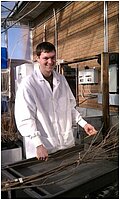Constructed Wetlands for Treatment of Tile-drainage Water and for Production of Biofuel

Alex Stalboerger is a Master of Science student within the Environmental and Conservation Sciences program at North Dakota State University. He holds a Bachelors of Arts in Biology and a minor in Botany from Minnesota State University Moorhead, MN. His work involves using constructed wetlands for the removal of sulfate from tile-drainage water and for the production of biofuel using a hybrid species of willow.
Email: alex.stalboerger@my.ndsu.edu
Phone: 701-388-7275
Fellow: Alex J Stalboerger
Advisor: Marinus L Otte, Ph. D., Professor, Wet Ecosystem Research Group, Department of Biological Sciences, North Dakota State University.
Co-Advisor: Donna Jacob, Ph.D., Research Assistant, Professor, Department of Biological Sciences, North Dakota State University.
Matching Support: North Dakota State University
Degree Progress: M.S. in Environmental and Conservation Sciences expected graduation in summer 2013. Academic coursework completed fall 2012.
Constructed Wetlands for Treatment of Tile-drainage Water and for Production of Biofuel
Treatment wetlands (TWs) are excellent tools for improving water quality and filtering of pollutants. They are used within industry as well as by private landowners to help control and reduce the impact of agricultural, industrial, and general anthropogenic influences on the environment. TWs provide many services, to humanity are hard to monetize. By manipulating the aerobic and anaerobic conditions of a TW it is possible to effectively target specific pollutants. Over the past decade the popularity of placing tile-drainage pipes within agricultural fields has been on the rise in the Midwest, especially west of the Red River of the North. Tile-drainage allows fields to dry faster in the Spring by channeling surface and groundwater through a series of pipes to a single outlet, allowing farmers to tend to their fields sooner than naturally possible in the spring. However, the increased rate of water drainage also increases the mobility of sulfate compounds within the soil. These sulfates might naturally be immobile in the absence of tile-drainage. Sulfates can cause detrimental downstream effects. Sulfate (SO42-), when chemically reduced to sulfide (S2-) by anaerobic conditions, can displace immobile phosphate from soil particles due to its higher binding affinity. Phosphate is known to cause eutrophic conditions within waterways because it is commonly a limiting reagent needed for algal growth. This study aims to show that TWs are effective for removing sulfate, and subsequent phosphate, from tile-drainage water and also to serve as productive land for biofuel using willow via gasification techniques. By serving as land for biofuel production using willow trees, landowners receive and upfront benefit from the TW.
Project Objectives:
The primary objective of this study is to show the efficacy of treatment wetlands for sulfate removal and biofuel production. The specific objectives include:
- Assess the efficacy of the wetland To remove sulfate from tile-drainage water. (In Progress)
- To control phosphate displacement from the wetland with the use of substrates and the wetland plant Typha angustifolia. (In Progress)
- Develop added value for treatment wetlands with the production of biofuel using Salix viminalis QC83 for biogasification. (In Progress)
- Determine the sources of tile-drainage water. (In Progress)
Progress:
Construction of the treatment wetland was completed in the fall of 2011. Data collection at the wetland will begin in the spring of 2012 after snowmelt. A baseline study to determine a length-to-mass ratio for willow species is in progress at the Jacob/Otte Refuge (https://sites.google.com/site/jacobotterefuge/home). Several laboratory and greenhouse studies are in development to help demonstrate the biogeochemical processes within the treatment wetland for sulfate remove and phosphate immobilization.
Significance:
The ability to combine ecosystem services (improved water quality) and monetary value (production of biofuel with willow) within wetlands is a great step towards supporting conservation efforts. This makes wetlands more attractive for potential land owners and those involved in wetland mitigation. By reducing downstream eutrophication, through the removal of sulfate from tile-drainage water and immobilization of subsequent phosphate, we greatly improve the water quality of the Maple River and all downstream bodies of water.
Conference/Seminar Presentations:
Alex J Stalboerger, Wei Lin, Donna L Jacob, Marinus L Otte. "Construction of a Treatment Wetland for Sulfate Removal from Tile Drain Water and For Production of Biofuel." Society of Wetland Scientists – North Central Chapter Regional Meeting, Jamestown, ND, September 2011. (Poster)

Marinus Otte
Biological Sciences
Office: Stevens 121
Telephone: 701-231-8708
Email: marinus.otte@ndsu.edu

Donna Jacob
Biological Sciences/Wet Ecosystem Research Group
NDSU


